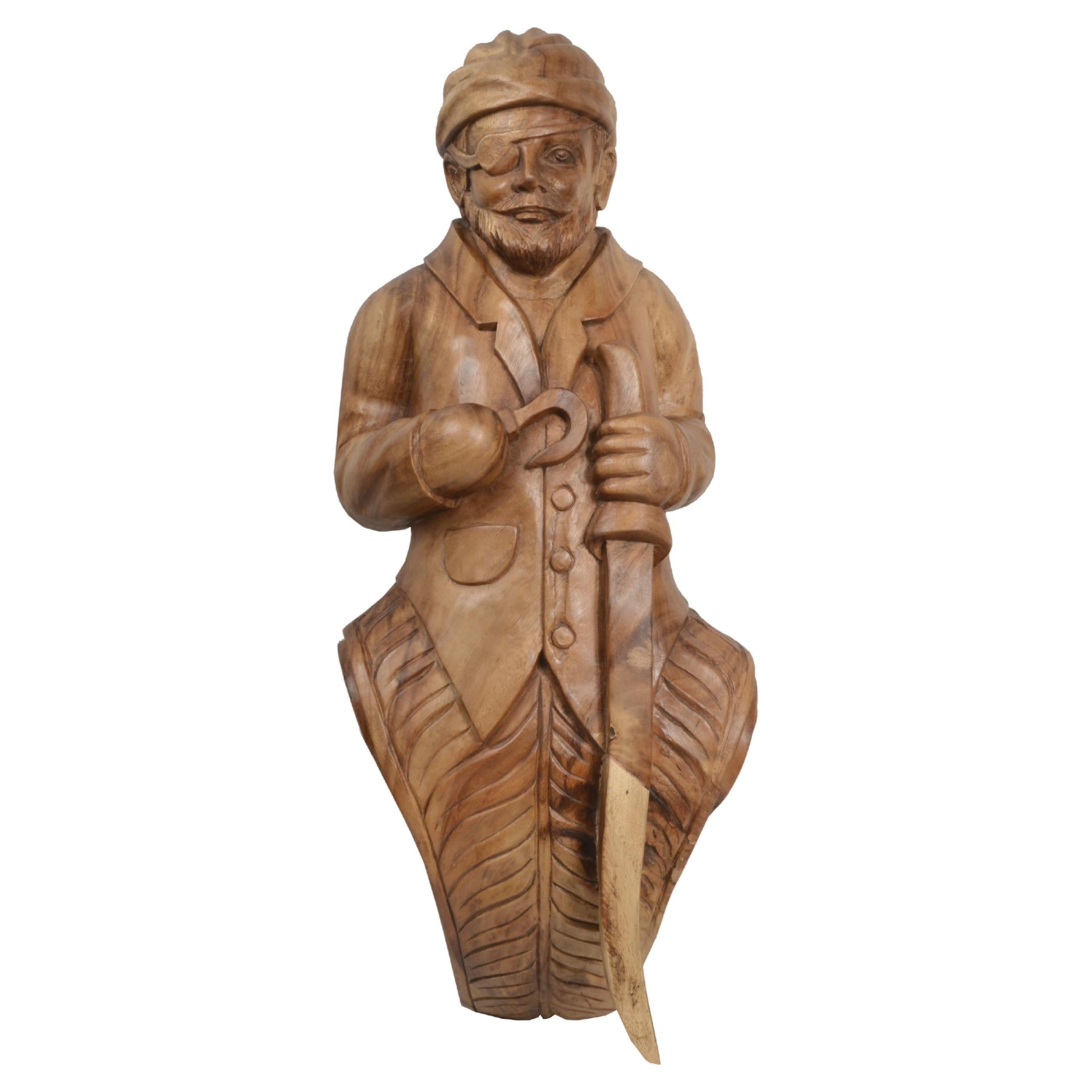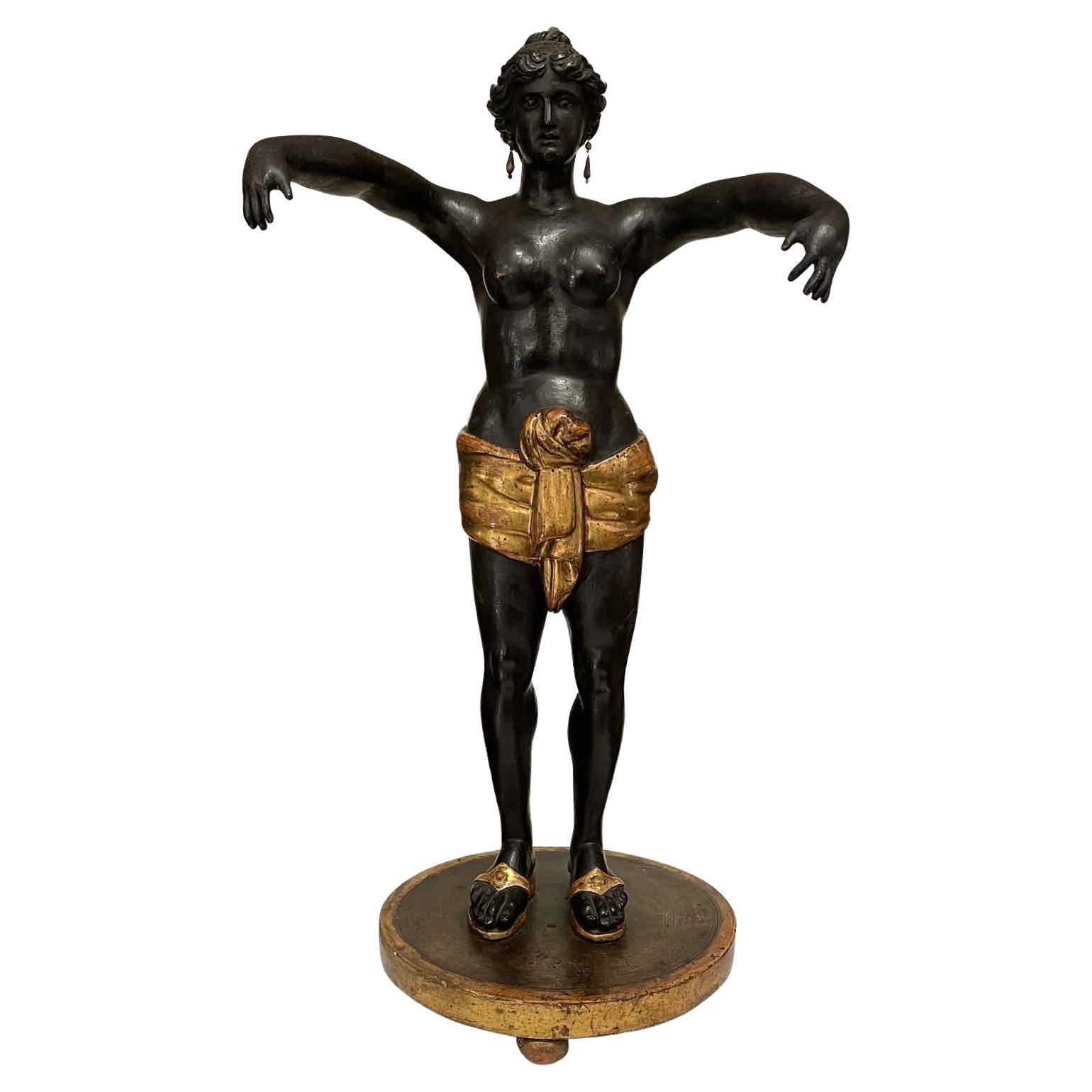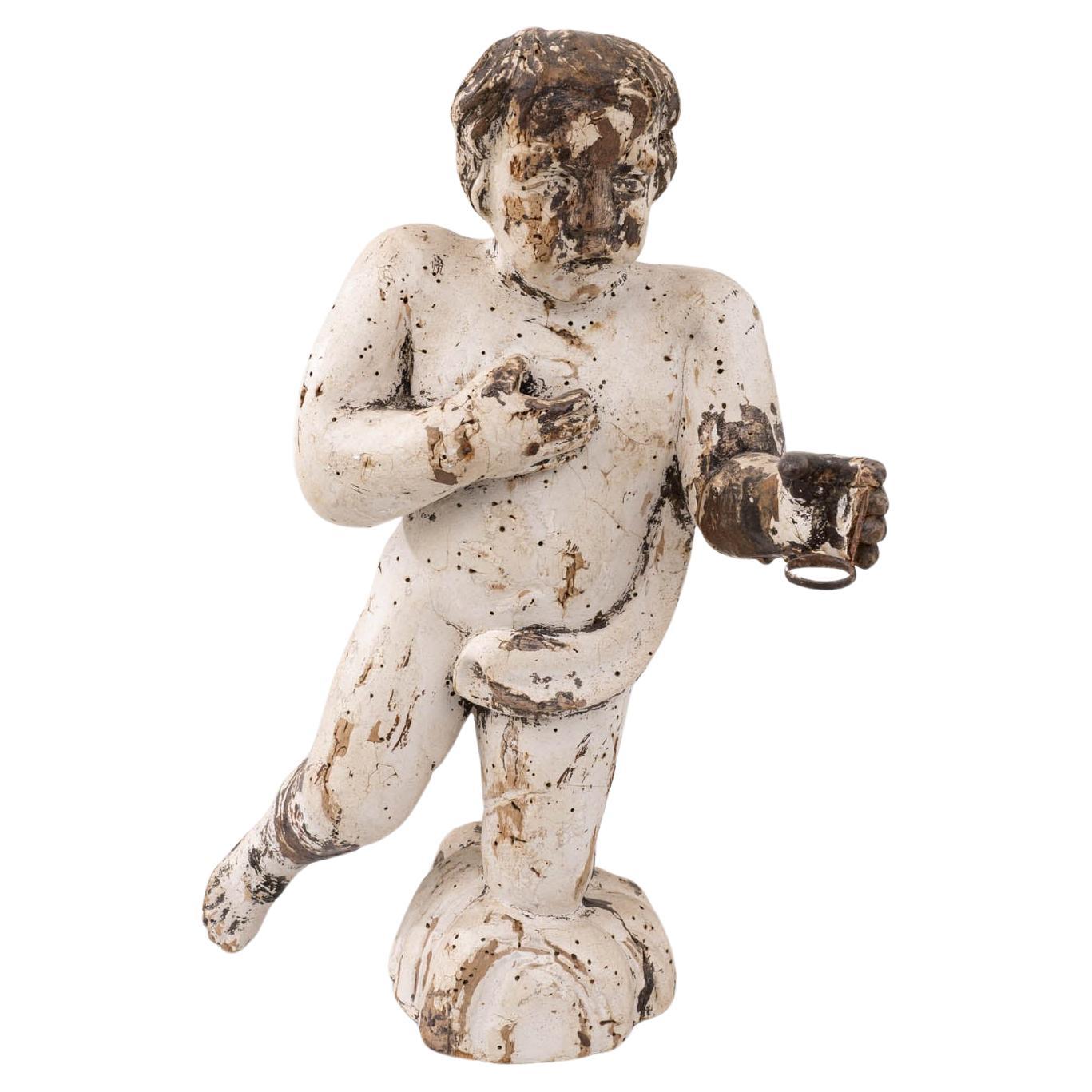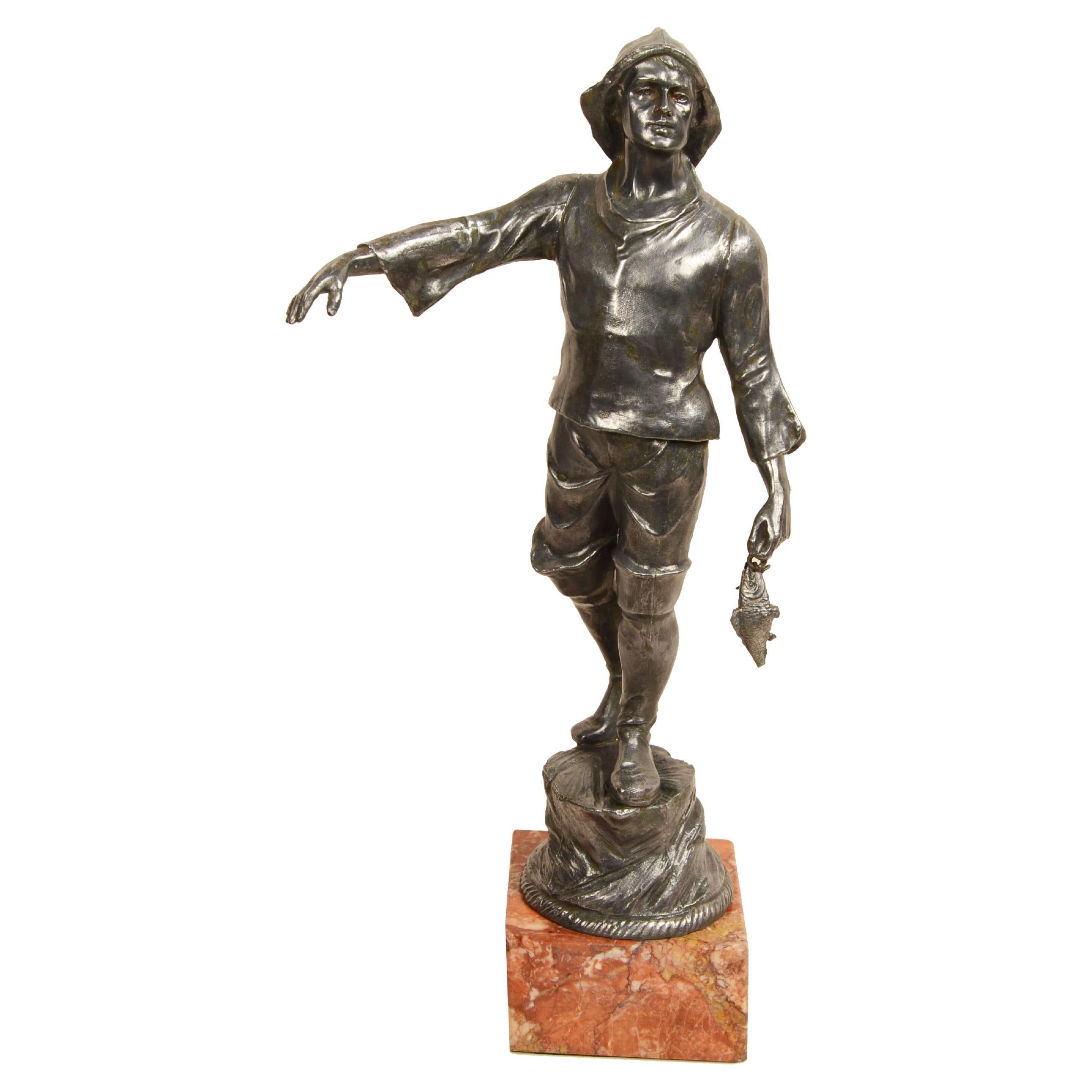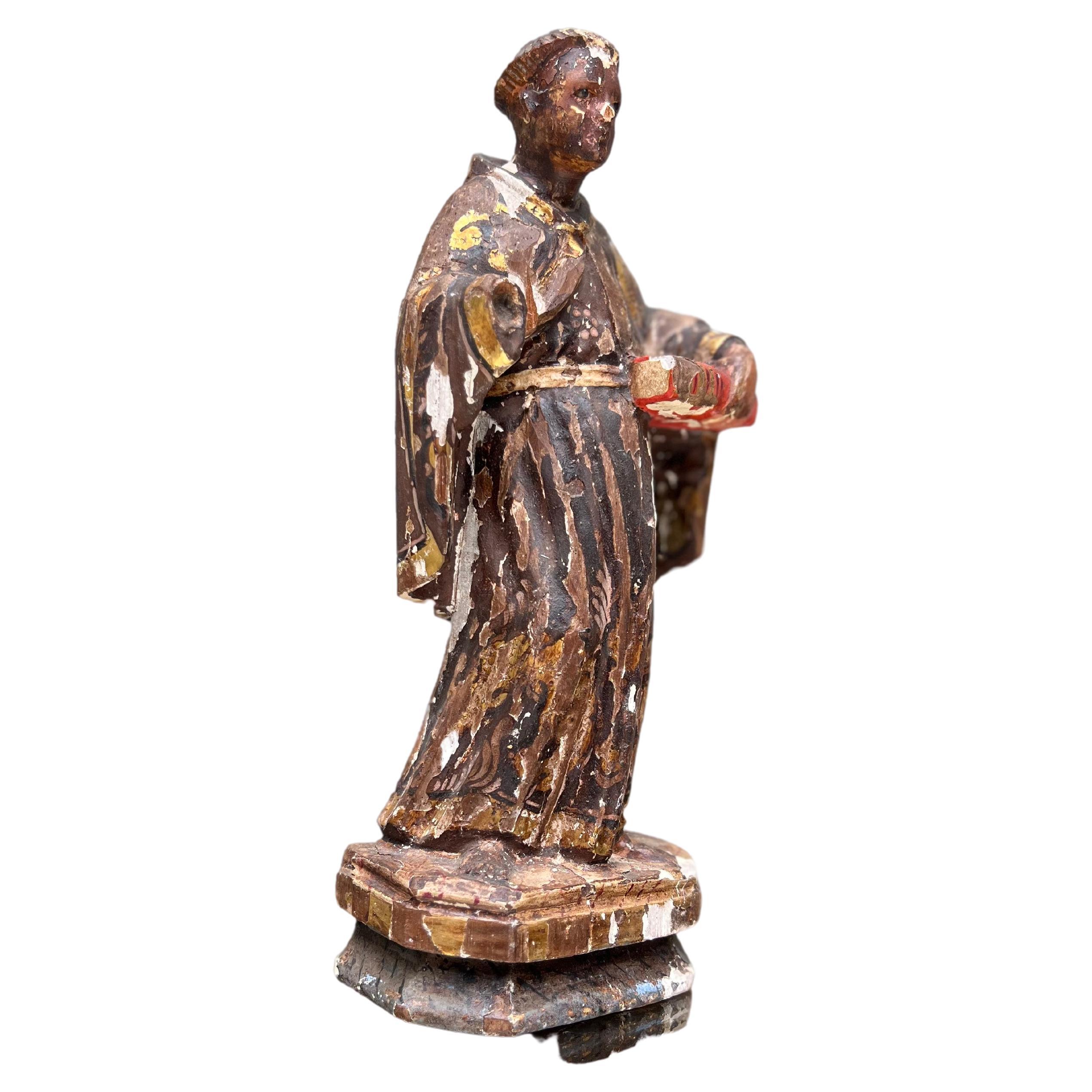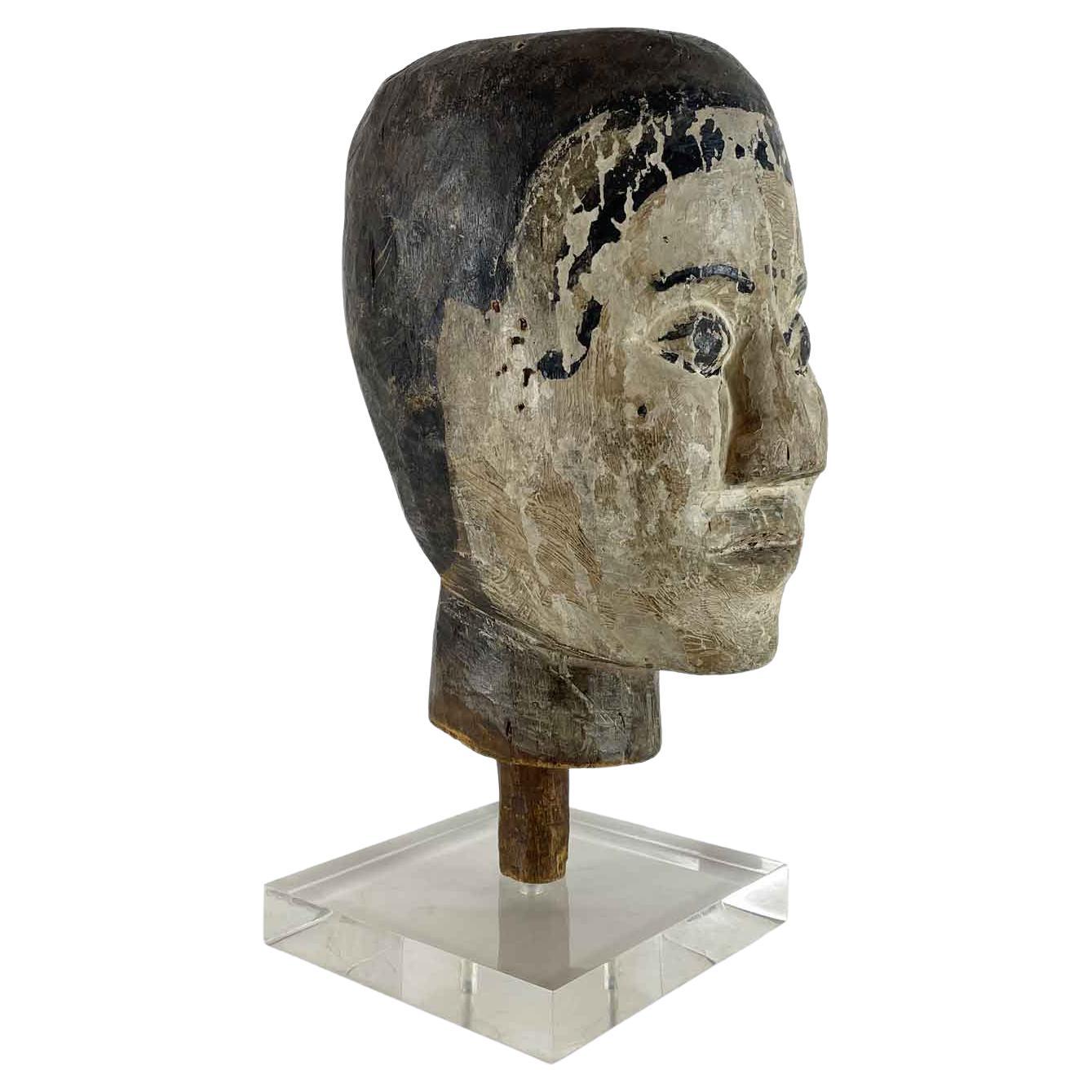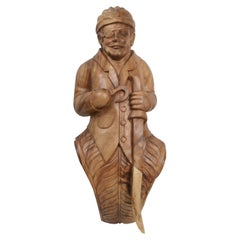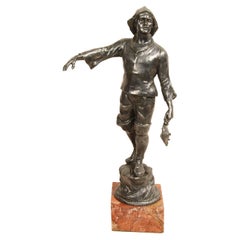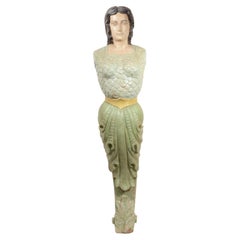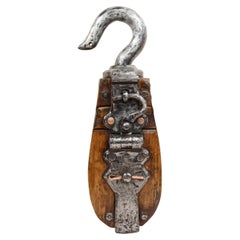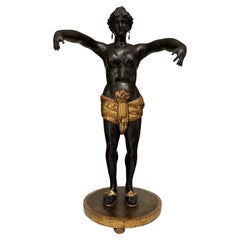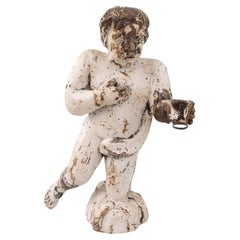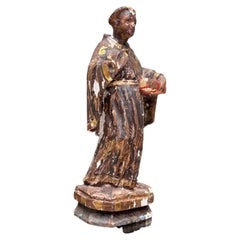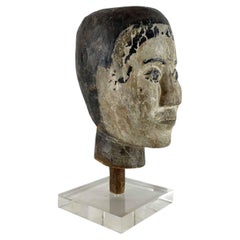Items Similar to Small carved wooden figurehead depicting young Moretto Venice late 19th century
Want more images or videos?
Request additional images or videos from the seller
1 of 20
Small carved wooden figurehead depicting young Moretto Venice late 19th century
$7,706.37
£5,767.39
€6,500
CA$10,631.61
A$11,822.79
CHF 6,209.59
MX$144,545.50
NOK 77,377.40
SEK 72,945.99
DKK 49,481.23
About the Item
Small carved wooden figurehead depicting young Moretto, mounted on red marble base, late 19th-century Venetian manufacture.
This is a beautifully crafted sculpture made of polychrome poplar wood that shows traces of gilding, depicting a young African man dressed as a sailor wearing a red blouse with short sleeves and fastened with a button at chest level.
In her left hand she clutches a rose, her legs are tapered to simulate those of a mermaid, and her terminal hoof is covered with leaves and flowers.
This sculpture belongs to late 19th-century Venetian production, evocative of the Venetian Republic's colonial past, and almost certainly never sailed.
The history of the Moors originates in the Middle Ages, passing through the 18th century, during the height of the splendor of the power of the wealthy maritime republic, to the 19th century where the Moor figure becomes a decorative motif in many areas of art, especially in sculpture, resulting in true masterpieces of tradition.
Good state of preservation, signs of restoration to the arms at the junction with the shoulder and some lack in the fingers of both hands.
Height 79 cm- inches 31, width 23 cm- inches 9, depth 23 cm- inches 9.
A figurehead is a wooden decoration found on the bows of ships from the 16th to the 19th century. The practice was first introduced in galleons, but even older ships often had some decoration in the bow. Like many of the austere decorations of the time, figureheads were intended to indicate the name of the ship that housed them to people who could not read; they were also meant to show the wealth and strength of the shipowner.
During the Baroque period some ships boasted gigantic figureheads, weighing many tons and sometimes even carrying two, one on each side of the foremast.
The large figureheads, being carved into solid wood and being placed at the tip of the hull, adversely affected the ships' seaworthiness. This, and the high cost of making them, led to much smaller figureheads being made in the 18th century and even eliminated in the following century. After the Napoleonic Wars, a few figureheads began to be produced again, but they depicted only small half-busts and not the large figures used in the past. Clippers of the 1850s and 1860s were generally equipped with full-length figureheads, but these were relatively small and light. La polena in quanto tale morì con la fine dell'utilizzo della propulsione a vela in larga scala. I primi piroscafi avevano delle strutture che ricordavano le polene sulla loro prua. This practice lasted until World War I.
About the Seller
5.0
Vetted Professional Seller
Every seller passes strict standards for authenticity and reliability
Established in 1999
1stDibs seller since 2014
398 sales on 1stDibs
Typical response time: 1 hour
- ShippingRetrieving quote...Shipping from: Milan, Italy
- Return Policy
Authenticity Guarantee
In the unlikely event there’s an issue with an item’s authenticity, contact us within 1 year for a full refund. DetailsMoney-Back Guarantee
If your item is not as described, is damaged in transit, or does not arrive, contact us within 7 days for a full refund. Details24-Hour Cancellation
You have a 24-hour grace period in which to reconsider your purchase, with no questions asked.Vetted Professional Sellers
Our world-class sellers must adhere to strict standards for service and quality, maintaining the integrity of our listings.Price-Match Guarantee
If you find that a seller listed the same item for a lower price elsewhere, we’ll match it.Trusted Global Delivery
Our best-in-class carrier network provides specialized shipping options worldwide, including custom delivery.More From This Seller
View AllPolena Da Nave in Legno Di Castagno Raffigurante Capitan Uncino Italia XIX Sec
Located in Milan, IT
Polena in legno di castagno scolpito del XIX secolo, raffigurante Giacomo Uncino meglio conosciuto come Capitan Uncino, famoso pirata e il principale antagonista di Peter Pan.
Uncino è il capitano immaginario di una nave di pirati crudeli.
Viene chimato così perché al posto della mano destra ha un uncino di ferro, la mano gli fu mozzata da Peter Pan durante un combattimento e poi data in pasto ad un coccodrillo, il quale gradì così tanto la mano che spera di mangiarsi anche il pirata al quale continua a dare la caccia.
L’opera, in legno di castagno scolpito è stata realizzata da un bravo scultore ligure, Italia del Nord, alla fine del XIX secolo, di ottima fattura ritrare il mezzo busto di un uomo barbuto, l’occhio destro bendato e l’uncino al posto della mano destra, mentre la mano sinistra impugna una grande spada e una bandana come copriacapo.
Il castagno è un legno pregiato e molto resistente alle intemperie e al vento.
La spada spezzata è stata restaurata in epoca precedente, per il resto lo stato di conservazione è molto buono.
Una polena è una decorazione lignea, che si trovava sulla prua delle navi dal XVI al XIX secolo.
La pratica fu introdotta inizialmente nei galeoni, ma anche navi più antiche avevano spesso alcune decorazioni nella prua.
Come molte delle decorazioni del Tempo le polene...
Category
Antique Late 19th Century Nautical Objects
Materials
Chestnut
Antimony sculpture depicting sailor French manufacture early 1900s
Located in Milan, IT
Antimony sculpture depicting the figure of a sailor, French manufacture from the early 1900s.
The beautifully crafted sculpture captures the elegant and athletic bearing of a tall, s...
Category
Early 20th Century Nautical Objects
Materials
Metal
Polena raffigurante una figura femminile Indie Orientali fine del XIX secolo
Located in Milan, IT
Polena raffigurante una figura femminile con i capelli sciolti e una cintura che le stringe la vita; è stata scolpita in legno di tiglio, nome scientifico Tilia, un legno molto usato nei lavori di intaglio, cosa che farebbe pensare a una nave costruita in un cantiere delle Indie Orientali attorno alla fine del XIX secolo, fatto frequente in molte navi della Royal Navy, benché la presente scultura per le fattezze appartiene certamente a una nave mercantile.
Le sue dimensioni sono 163 cm di altezza – inches 64.20, 48 cm – inches 18.8 di larghezza massima misurata all’altezza delle spalle e cm 30 – inches 11.8, di profondità.
Sotto lo strato di vernice di colore verde chiaro, più recente, ci sono tracce di una colorazione bruno-marrone, probabilmente una pittura usata per la conservazione del legno. La scultura è stata eseguita a mano con uso di sgorbia. La mancanza di braccia è tipica delle polene...
Category
Antique Late 19th Century Nautical Objects
Materials
Wood
Grande bozzello in legno e acciaio con puleggia in legno duro. Inghilterra 1850
Located in Milan, IT
Grande bozzello in legno e acciaio con puleggia in legno duro cassetta, ovoidale in legno con una cavatoia apribile in parte con cerniera e gancio di chiusura, nella quale è imperni...
Category
Antique Mid-19th Century Nautical Objects
Materials
Wood
English scale model of recreational sloop with mainsail mast and jib 1930
Located in Milan, IT
Scale model of a recreational sloop equipped with a mast with mainsail and jib.
Early 20th-century English manufacture, made of wood, brass, rope, and cloth on wooden base, dark wood...
Category
Vintage 1930s Nautical Objects
Materials
Wood
Rare late 19th century cast brass "Jack Tar" umbrella and sailor stick holder.
Located in Milan, IT
Rare cast brass "Jack Tar" umbrella and sailor's staff holder, English manufacture datable to around the late from the 19th century.
The umbrella stand is depicted by a sailor Jac...
Category
Antique Late 19th Century Nautical Objects
Materials
Brass
You May Also Like
Goddess Circe Italian Neoclassical Sculpture Early 1800s Carved Ebonized Re-gilded
Located in Milano, MI
Circe Italian Neoclassical Sculpture of Early 1800s the figure is a fascinating depiction of the Goddess Circe, made in Italy in the early 19th century. The pine wood carving and ebo...
Category
Antique Early 19th Century Italian Neoclassical Figurative Sculptures
Materials
Hardwood, Pine
18th Century Italian Wooden Sculpture
Located in High Point, NC
This 18th Century Italian Wooden Sculpture captivates with its rustic allure and storied past. Carved with a delicate yet masterful hand, it portrays the figure of a cherub, a timele...
Category
Antique 18th Century Italian Figurative Sculptures
Materials
Wood
Antica scultura lignea Raffigurazione di Santo
Located in Milano, MI
Antica scultura lignea Raffigurazione di Santo
Descrizione
Antica scultura policroma lignea
Presenta mancanze date dal tempo
1800
Produzione: Ita...
Category
Antique Mid-19th Century Italian Figurative Sculptures
Materials
Wood
Asian Lacquered Head In Carved Wood Early 1900s
Located in Milano, MI
Lacquered Head In Sculpted Wood Early 1900s mounted on a plexiglass base 3 cm. high with the neck truncated for attachment to the body by means of a pin. Despite having widespread co...
Category
Early 20th Century Southeast Asian Tribal Figurative Sculptures
Materials
Wood
Wooden angel possible French Rococo
Located in Lugo, IT
Wooden angel should be French 1700/800s
Not perfect condition, missing and broken
Thank you
Category
Antique Mid-17th Century French Rococo Figurative Sculptures
Materials
Wood
19th Century Italian Articulated Wooden Figure
Located in London, GB
19th century articulated wooden figure
We are proud to offer a rare survivor from the 19th century, in the form of a hand carved pine figure of a soldier. With a polychrome painted...
Category
Antique 1870s Italian Early Victorian Toys and Dolls
Materials
Pine
More Ways To Browse
Antique Moro
Boat Diorama
Nautical Woolies
Driftwood Boats
Sailors Valentine Shell Boxes
Skylight Compass Binnacles
Barbados Shell
Nautical Onion Lantern
Antique Fishing Lures
Sperm Whale Teeth
Whaling Harpoon
Vintage Fishing Lure Display
Antique Flensing Knife
Italian Bulb
Modern Italian Chandeliers
Vintage Mid Century Modern Dining Set
Antique Kingdom
Brass Table Base
